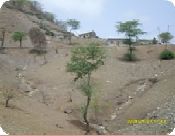|
Rangeland fencing: experimental results and conclusions |
 |
|
 |
The eastern and central part of the Greek island Crete is suffering from land degradation problems, while the rest of the island is highly sensitive to desertification. Soil erosion due to surface runoff and tillage operations, collapse of terraces, overgrazing, salinization of lowlands, and overexploitation of ground water are the major processes of land degradation in the area. A lot of forested areas were converted into cultivated land In the last century. Overgrazing and fires further destroyed the natural vegetation cover and prevented its regeneration. |
Overgrazing on the shallow stony soil decreases cover and destroys soil structure, and therefore promotes runoff and erosion. This further destroys what little soil there is left and jepordizes the entire ecosystem that depnds on it. Erosion is therefore see as the main problem and a driver behind evironmental degradation.
| Experiment: rangeland fencing to reduce overgrazing effects |
The experiment was carried out near Agia Barbara village on a steeply sloping overgrazed land (23% slope) with shallow soil (35-45 cm deep). Four runoff plots of size 10 m² were established (two treatments with two replicas with (a) sustainable grazing (SG), and (b) overgrazing (NSG). At the bottom of each plot a drainage ditch and a tube connecting to a dipping bucket and a sediment trap are installed to collect surface runoff and suspended sediment from the corresponding LMPs with their replicates. Meteorological variables are measured at the same field using an automatic station (see photo below). The experimental station is remotely controlled from the laboratory of Soils in the Agricultural University of Athens.
Soil aggregate stability, particle size distribution, and soil organic matter content were measured twice during the execution of the experiment (12/11/2008, and 30/9/2010). Plant cover was recorded periodically throughout the period during which field observations were carried out.
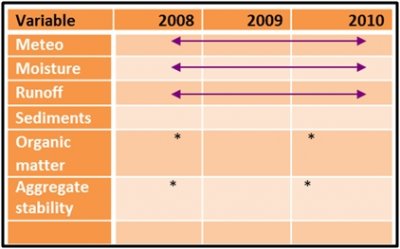 |
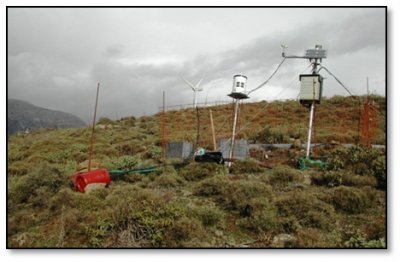 |
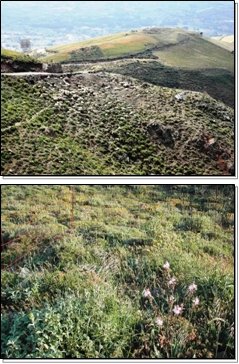 |
In year 1 and 2 of the experiment annual rain was 520 mm and 625 mm respectively. During that period 10 big rainfall events occurred for which surface runoff volumes were measured. In the sustainable grazing plots the annual as well as the perennial vegetation and the plant residues covers about 85% of the soil surface, protecting the soil from splash detachment, formation of surface crusting, and minimizing surface runoff. The sustainable grazing management practice reduces surface runoff by more than half in both the study years. In year 1, surface runoff from overgrazed plot was 43.7 mm and that of sustainable plot was 28 mm. In year 2, the difference was even more (19 mm verses 7 mm).
Sediment loss was similarly affected by grazing intensity. As shown by figure above sediment losses in the overgrazed plots in year 1 is 352 kg ha-¹ yr-¹ whereas it is 143 kg ha-¹ yr-¹ in the sustainable grazing plot. Similar result is shown in year 2. The result shows that soil losses can be minimized by about 2.5 times by employing sustainable grazing.
Overgrazed area (top); fenced area (bottom)
|
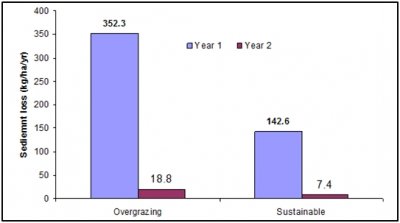 |
Effect of grazing management practices on soil losses
|
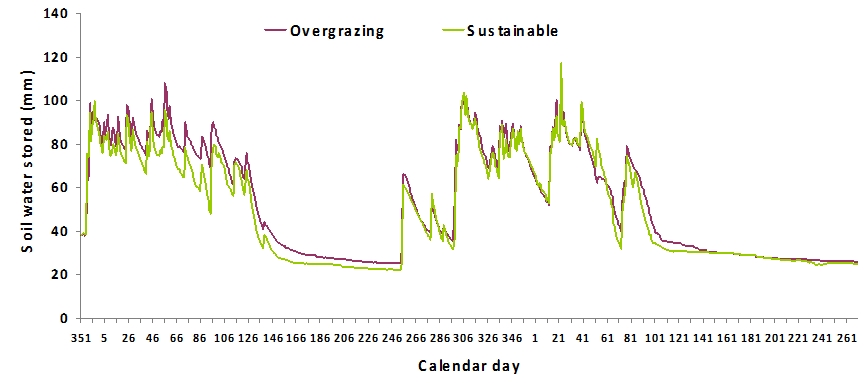 Soil moisture monitoring in the two plots. A slight increase in soil moisture is measured in the first year while in the second year the moisture contents are almost equal. Soil moisture monitoring in the two plots. A slight increase in soil moisture is measured in the first year while in the second year the moisture contents are almost equal.
 |
The results are evaluated from a production, socio-cultural and economic point of view. The bars express the estimated or measured percentage of change with respect to the reference situation. This change can be positive (blue) or negative (red). Note that this evaluation is based on the experiments, on the long term experience of the coordinating team in this area and on consultations with the farmers. |
- While this is ecologically a good measure, fencing would be very costly for very little return for land owners. Rangeland resting where agreements are made to leave an area as set aside without fencing might be possible. However, the landowners receive EU subsidy based on the number of animals so this effectively negates any means to protect the fragile soil. Since fencing or set aside would mean a decrease in animal density, this is a further loss of income.
| The experiment shows that the sustainable grazing results in minimizing surface runoff and sediment loss by more than half of that in the overgrazed areas. Sustainable grazing results in increasing plant cover and biodiversity, higher soil organic matter content and higher soil water storage. This shows that soil loss in this case is not only about sediment dynamics (the losses are actually small in absolute values), but these thin and fragile soils are an important part of natural ecosystem. |
| The main bottleneck is the reduction of farm income due to reduced number of grazing animals. Currently the farmers receive EU subsidy based on the number of animals they have. The policy of farm subsidy has to be changed if the SLM technology has to be successfully implemented. Also funds should be made available to compensate for the reduction of animals. In this case conservation would mean providing an alternative means of income or some form of compensation, i.e. changing the subsidy from heads of lifestock to nature conservation. |
|

